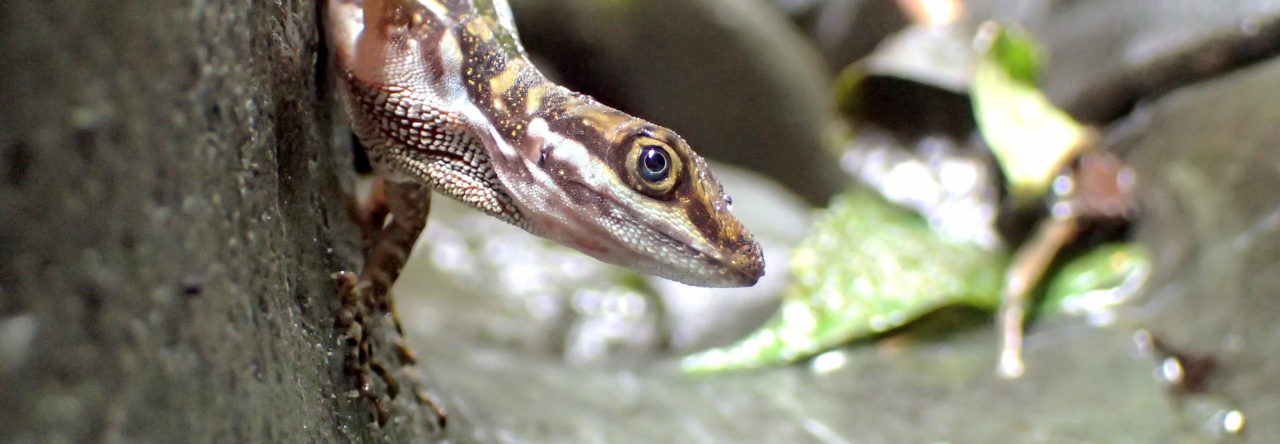Many species of anoles exhibit sexual dimorphism in back patterning, often with the male being relatively uniform and the female festooned with stripes, diamonds, speckles or other geometries (in a few cases, the situation is reversed and the males are the dandies). Surprisingly, there are no reviews documenting the extent of this phenomenon, much less comparative studies explaining its significance (adaptive or otherwise).
Perhaps even more interesting, in some species females exhibit multiple pattern phenotypes within a single population. Most study to date has focused on A. sagrei in the Bahamas. The seminal paper on this topic was Schoener and Schoener’s 1976 study in Evolution, which suggested that pattern variation was related to crypsis, with different patterns being more cryptic in different parts of the structural habitat (e.g., stripes are cryptic on narrow branches). In support of this hypothesis, the Schoeners showed that within a locality, females with different patterns occurred in different parts of the habitat, and among sites, the relative frequency of the types varied in relation to inter-site variation in vegetation.
After a three-decade hiatus, research on A. sagrei female back pattern polymorphism was re-initiated by Ryan Calsbeek and lab members in the central Bahamas. On islands in this region, three pattern morphs (pictured above) can be found. Laboratory breeding studies reported last year indicate that back patterning is a genetically heritable trait with a complicated genetic basis involving at least two genes. That this variation does not have a simple genetic basis is not surprising, because the three back patterns are not discretely different entities. Rather, the middle pattern—termed “diamond-bar”—is clearly intermediate between the other two, and this category contains a wide variety of different phenotypes. In some sense, it would seem that there is a continuum in phenotypes, with diamond at one end, bar at the other, and everything else lumped as diamond-bar (this is not to say that the distribution of phenotypes is uniform; it may well be tri-modal, justifying the simplifying recognition of three phenotypes). Furthermore, examination of the photographs above reveals that the variation may result from a relatively simple developmental mechanism because the different phenotypes could be produced by altering the extent to which the lateral black line running down each side of the center of the back continues linearly or invaginates. A linear progression produces the bar pattern, extreme and repeated invagination produces the diamond pattern, and an intermediate amount of invagination leads to the intermediate, diamond-bar patterns. Certainly, understanding the developmental mechanisms that produce this variation, as well as its underlying genetic basis, would prove fascinating.
Developmental genetics issues aside, a classic question in evolutionary biology is how to explain the existence of phenotypic variation in a population. Why do these different variants all occur in these populations, and why not in others? Cox and Calsbeek recently tackled this question by examining the hypothesis that females differing in their back patterns also differ in other characteristics that matter for survival and reproduction. If such differences in fitness exist, there are a number of different ways that selection could act to maintain variation, such as by favoring individuals that are the most genetically variable or by favoring particular phenotypes when they are rare. However, examination of rates of egg production and the number, frequency and sex ratio of offspring found no evidence for differences among the pattern morphs. Moreover, by removing eggs from females, the authors showed that reproduction is costly, but that the costs of reproducing also do not differ among morphs. In addition, in nature, the morphs didn’t differ in survival, growth, or various measures of parasitism and immune system functioning. As a result, the authors conclude “This raises the question of what selective forces, if any, are acting to maintain this polymorphism.” A good question, indeed, and one no doubt being further investigated by these workers.
- Evolution in Real Time on Lizard Island - March 23, 2025
- Spider Snags Adult Anolis osa - March 22, 2025
- An Homage to the Green Anoles of New Orleans - March 21, 2025



4 Pingbacks